Rothko in Lampedusa. The United Nations High Commissioner for Refugees offered five young refugee artists a residency in Venice during May to coincide with the Biennale.
Barca Nostra lies at the far end of the Arsenale in Venice. To get to it you have to make your way through seemingly endless installations in this section of the Biennale, some well lit, some in disorienting darkness. It's a bit like shopping in an old-fashioned department store: you know what you want but first you have to go through sections of what you don't want, stopping occasionally to look at something exotic that catches your eye.After making your way through several wings of the Arsenale, once the home of the Venetian republic's shipyards and armoury, you are out in the open again, looking over the now almost empty docks. In the stark light of May-time Venice there it is, the fishing boat in which over 800 people lost their lives four years ago. It is at once overpoweringly big – as it soars above you with the gaping holes in its side – and too small. How could over 800 people have been crammed into that hull? There were less than 800 viewing the art in the Arsenale that morning; to have loaded all of them into a similar craft and set off into the windy Adriatic would have been inconceivable. And yet that's what happened in April 2015 when this fishing boat was loaded up in Libya and then collided with a freighter in international waters between Libya and Lampedusa. There were only 28 survivors. The exact number of those who drowned still isn't known; boats full of refugees don't have passenger lists.
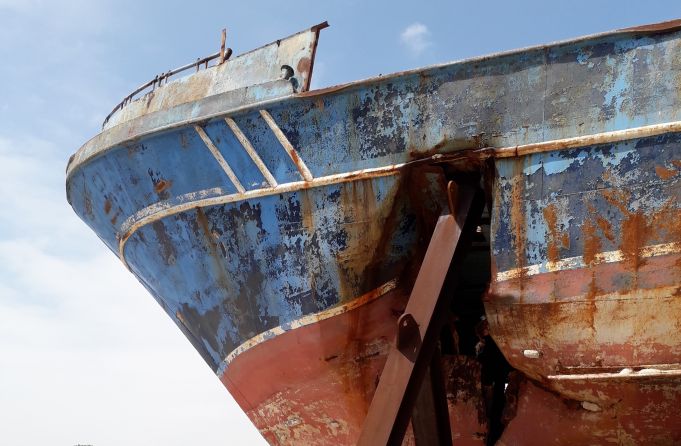
Barca Nostra has been brought to the Venice Biennale by Swiss artist Christoph Büchel. There has been much discussion as to whether it is art. One critic has pointed out that it doesn't have a label to tell you what it is; isn't that just the point? These boats don't have labels. Other criticism opines that showing off the boat is exploiting people's misery; isn't that just the point too? This is exactly what human traffickers do when they cram over 800 people into a fishing boat with enough space for about 15. Whether or not you decide this wreck merits the label “art”, there is no ducking the fact that one way or another Barca Nostra is indeed Our Boat. This boat is our boat and its tragedy is our tragedy too.
But there is more than tragedy on show in Venice this year; there is also the success that follows tragedy. Off the tracks of the official Biennale, down one of the winding streets of Dorsoduro, is a small exhibition called Rothko in Lampedusa* organised by the United Nations High Commissioner for Refugees (UNHCR) and sponsored by the big Italian bank Unicredit. In Palazzo Querini there are the works of eight well-known artists who have made forced displacement a major theme of their work and five lesser-known ones who are now beginning to make their names. The five were selected from a much longer list of about 20 for a month-long residence in Venice during May to coincide with this year's Biennale. But one, Hassan Yare from Somalia, who lives in the sprawling Dadaab camp in northern Kenya, didn't make the residency although his cartoons of life in Dadaab are on display.
The obvious tie-in with the boat theme is in the first room of the building with the moving series of charcoal drawings of a rescue at sea called Politics of drawing, Lampedusa, 2019 by established artist Adel Abdessemed. Ai Weiwei, the celebrity of the show, supplies the link with the Rothko theme showing a small, understated, rectangular block of black Lego bricks, which he wittily titles One millimetre taller than Rothko's black, black on wine, 1968.
Almost all the work of the established artists distills a sense of unease. Christian Boltanski's room full of gold survival blankets under a swaying light immediately makes you feel seasick in a claustrophobic space you sense is full of bodies. Richard Mosse's large-scale people-less heat maps of vast industrial spaces are a chilling reminder of the military use of modern photographic techniques. Abu Bakarr Mansaray's work Ebola Virus Missile Industry oozes the evils of war not just in its title but also through all the minute details of its composition. Artur Zmijewski's video portraits of black urban workers capture their unbearably haunted and bewildered expressions as the camera mercilessly strips them of their dignity.
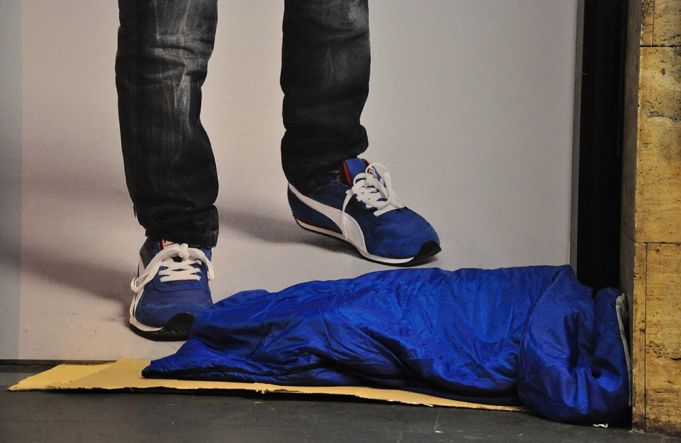
In contrast, the work of the five young artists has none of this edginess of despair or violence. Mohamed Keita, who fled the civil war in the Ivory Coast when he was 14 and arrived in Italy three years later, now lives and works in Rome. His photos have an unusual tranquillity about them, even though they are often against the background of urban degradation. He said he started photography when he arrived in Rome, largely because he didn't have any photographs of the family he had left behind and therefore felt that he must have something to remind him of the life he is now living, mainly around Stazione Termini. What is particularly touching about his work is that, unlike Zmijewski, he makes his point without ever showing the subject's face. He focuses on feet, on backs, on just the body-shaped lump of a homeless person in a sleeping bag. This is intentional, he explains, in order to maintain the other person's privacy and dignity.
Majid Adin's animation for Myela, a song by Nick Mulvey, is masterful, and tells a simpler and even more moving tale than his award-winning animation for the video of Elton John's Rocket Man. Both reflect Adin's own experiences on his journey from Iran (which he left because his criticism of conservative religious practices had alerted the police and forced him into hiding), through the Calais Jungle and then in a refrigerator lorry to the UK. Myela is in part based on the story of the escape by boat of a young pregnant Sudanese woman to Lampedusa (“God only knows how she survived, so many other families have died,” goes a verse of the song). It narrates the hope, the danger, the despair and then finally the plea to free her “from the cage of this supposed civilisation”.
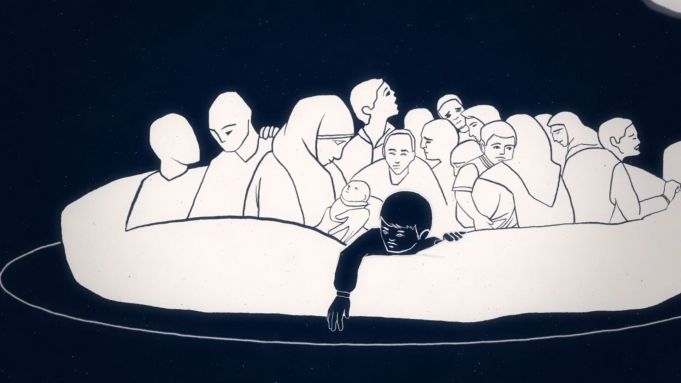
Bnar Sardar Sidiq, who comes from the Kurdistan region of Iraq and now lives in Bristol, displays a photo story of two families, one Christian and the other Sunni Muslim, living under the same roof in a small refugee community. The photos of everyday life in this temporary home are unusually tender and loving. The old woman preparing her husband (one assumes) for a haircut and the middle-aged man feeding a disabled person lying helpless in the background are perhaps the most memorable.
The small sculptures in wood and stone by Rasha Deeb from Damascus, who is now based in Germany, give an idea of both how complex and how simple her work can be. Some of these small works in wood and stone are elaborately carved; others are plain, polished shapes in stone. Sadly, their details were difficult to pick out, placed as they were against the light.
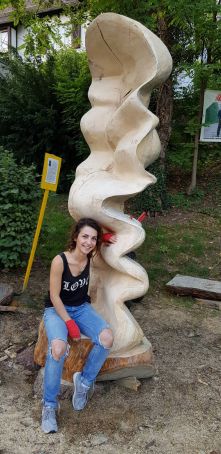
A better indication of what Deeb can create (she also paints in watercolour and acrylic) comes from the video playing in another Venice venue, in the Istituto Europeo di Disegno (IED) on the second floor of Palazzo Franchetti, where the Dubuffet in Venice exhibition is showing. It films her usual way of working, wielding a hefty chainsaw to cut into the huge tree trunks she transforms into her three-metre-high sculptures. She explains that she had wanted to bring one of them to Venice but that it was just too big. She also has in mind a project to make a sculpture out of one of the Venice bollards that stick up all over the lagoon. But not being as quick and easy to execute as the Banksy image of a child refugee holding a rescue flare which unexpectedly appeared overnight on a canal wall, Deeb admits that her project will have to wait another day.
The exhibition at the IED called Fluidity of Languages and curated by IED students also displays another Sidiq photo reportage. It is titled The Garden of Eden is likely to disappear and shows the dwindling life in this once-fertile area of Iraq now endangered by war, by climate change and by the drought caused by dams built in Turkey. Sidiq relates that she became a photo reporter – at one stage she was the only Iraqi woman photo reporter working in the country – because she felt that the fly-in-fly-out foreign war reporters were showing only one side of a much bigger story that she could document from her own experience. She says she is thinking about two new projects as a result of her residency in Venice, but is keeping them to herself for now.
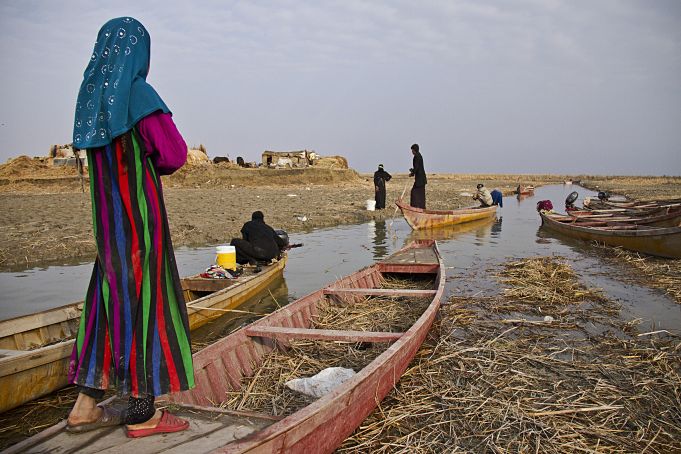
The exhibition at the IED also includes a glimpse of Adin's new projects, the design and illustrations for a book of poetry, the graphics for a novel with the provisional title Shakespeare and Hamid, sponsored by the Good Chance Theatre, and an animation for Art Refuge UK.
One wonders how Venice will rub off on all four artists in their future work. Perhaps it was the month's residency on the lagoon, thanks to the hospitality of Refugees Welcome Italia families, who hosted them for the first week, as well as the support of UNHCR that made them appear so happy, enthusiastic and – dare one say it? – at home. But perhaps there was something more, too: the courage and determination to move on, to look forward, defined both by the hazards of their journey out and the longing of all exiles for the journey home.
By Mary Wilsey
*The UNHCR has used Mark Rothko as a major example of a refugee who went on to become one of America's major contemporary artists; the Lampedusa of the title needs no explanation. The exhibition, curated by Luca Berta and Francesca Giubilei, is in Palazzo Querini, Calle Lunga S. Barnaba. Get off the vaporetto at Ca' Rezzonico, walk through Campo S. Barnaba into Calle Lunga and you will find the charming Palazzo Querini, part of the Fondazione Ugo and Olga Levi, on the left. The exhibition runs until 24 November. The smaller show at the IED is no longer showing.
This article was published in the July 2019 edition of Wanted in Rome magazine.
General Info
View on Map
United Nations holds exhibition by refugee artists at Venice Biennale
Calle Lunga S. Barnaba, 30123 Venezia VE, Italy


















